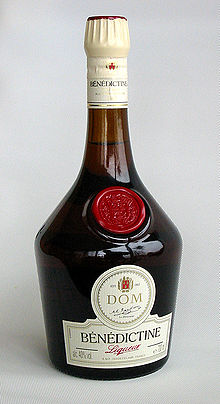- Bénédictine
-
Bénédictine is an herbal liqueur beverage developed by Alexandre Le Grand in the 19th century and produced in France.
It is claimed that at the Benedictine Abbey of Fécamp in Normandy, monks had developed a medicinal aromatic herbal beverage which was produced until the abbey's devastation during the French Revolution and that from this Le Grand developed the formula now in use.[1].
He began production under the trade name "Bénédictine", using a bottle with an easily recognizable shape and label. The family eventually sold the company to Martini and Rossi, which was in turn bought by Bacardi.
The recipe is a closely guarded trade secret, ostensibly known to only three people at any given time. So many people have tried to reproduce it that the company maintains on its grounds in Fécamp a "Hall of Counterfeits" (Salle des Contrefaçons) The bottle and label have been imitated, as has the name Bénédictine. The company prosecuted those it felt to be infringing on its intellectual property. It lost in litigation against the Santo Domingo de Silos Abbey in Spain,[citation needed] after it was demonstrated that the monks there had been making their liqueur for a longer time.
The manufacturing process involves several distillations which are then blended.
The same company also produces "B & B" (or Bénédictine and Brandy), which is Bénédictine diluted with brandy, making it less sweet than Bénédictine. B & B was developed in the 1930s when consumers began a trend of mixing Bénédictine with brandy to produce a drier taste. Bénédictine is 40% alcohol (80 proof), while B & B is 43% (86 proof). Also, the company introduced in 1977 a 60 proof (30% alcohol) coffee liqueur, Café Bénédictine, a blend of Bénédictine and a coffee-flavoured liqueur. Additionally, the company produces a Bénédictine Single Cask that comes in a black bottle and is only available at the Palais de la Bénédictine's store in Fécamp, Normandy, France.
Every bottle of Bénédictine has the initials D.O.M. on the label. Mistakenly thought by some to refer to "Dominican Order of Monks"[citation needed], it actually stands for "Deo Optimo Maximo"; "For our best, greatest God". (The Dominican Order uses the designation O.P., which refers to "Order of Preachers".).
Burnley Miners' Club in Lancashire, United Kingdom is the world's biggest single consumer of Benedictine liqueur, after Lancashire regiments acquired a taste for it during the First World War.[2][3]
Cocktails using Bénédictine besides the B & B include the Frisco[4], Derby, Singapore Sling,[5], Vieux Carré[6], and Monte Carlo.[citation needed]
References
- ^ According to an interview of Alain Le Grand, last family owner of the distillery in the TV-Document Le Palais bénédictine de Fécamp on FR3 – Normandie.
- ^ List of QI episodes (D series)#Episode 6 "Drinks"
- ^ "Liqueur is hot stuff at working men's club", The Independent
- ^ Bruni, Frank (28 October 2010). "The Tipsy Diaries: Finding the Frisco Cocktail". The New York Times. http://www.nytimes.com/2010/10/29/dining/29tipsy.html?_r=1&ref=dining.
- ^ Campbell, Colin (12 December 1982). "Singapore Journal; Back to Somerset Maugham and Life's Seamy Side". The New York Times (Singapore). http://www.nytimes.com/1982/12/12/travel/singapore-sling-is-spoken-here.html.
- ^ [1]
Sources
- Harold J. Grossman and Harriet Lembeck, Grossman's Guide to Wines, Beers and Spirits (6th edition). Charles Scribner's Sons, New York, 1977, pp. 377–8. ISBN 0-684-15033-6
- http://www.ufppc.org/content/view/4276/36/
- Jean Pierre Lantaz, Bénédictine, d'un alambic à cinq continents, éditions Bertout 1991.
- Stéphane Nappez, Le palais Bénédictine, éditions PTC 2005
External links
Categories:- French liqueurs
- Herbal liqueurs
- Norman cuisine
Wikimedia Foundation. 2010.





